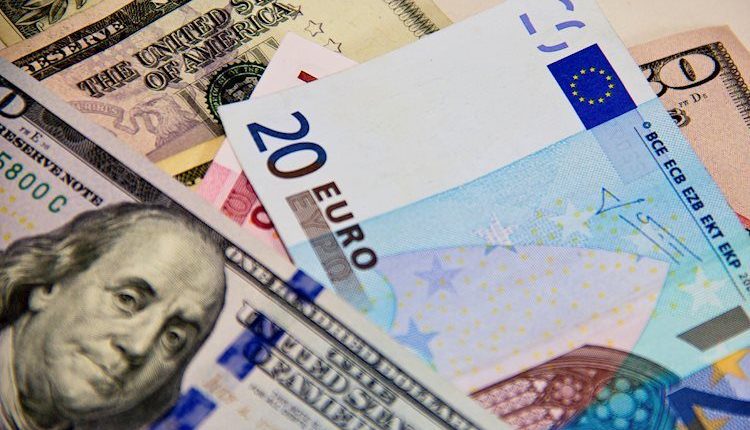- The Euro accelerates the decline near 1.0700 vs. the US Dollar.
- Stocks in Europe trade mostly with losses on Tuesday.
- EUR/USD’s upside momentum falters ahead of 1.0770.
- The USD Index (DXY) regains some balance following Monday’s drop.
- Germany Economic Sentiment improves a tad in September.
- The NFIB index came in below estimates in August.
The Euro (EUR) fades the auspicious start of the week against the US Dollar (USD), prompting EUR/USD to return to negative territory and trade close to the 1.0700 neighbourhood after climbing to as high as the 1.0770 region earlier on Tuesday.
In the meantime, the Greenback reclaims some buying interest following Monday’s strong retracement and encourages the USD Index (DXY) to shift its attention to the key hurdle at 105.00 the figure so far.
In terms of monetary policy, the anticipation of a potential interest rate hike by the Federal Reserve (Fed) in November seems to have waned recently, while market participants persist in factoring in the likelihood of rate cuts taking place at some stage in the second quarter of 2024.
Turning our attention to the European Central Bank (ECB), market discussions seem to lean towards a pause at the September 14 meeting and a quarter-point rate raise by year’s end, given the current state of a somewhat divided Council.
Back to the euro calendar, the Economic Sentiment gauged by the ZEW Institute improved to -11.4 in September in Germany and worsened to -8.9 when it comes to the broader euro area. In the US, the NFIB Business Optimism Index receded to 91.3 during last month, while the usual weekly report on US crude oil supplies by the API is due later in the NA session.
Daily digest market movers: Euro opens the door to extra decline near term
- The EUR gives away part of Monday’s gains vs. the USD.
- The absence of direction prevails in the US, German yields so far.
- Markets see the ECB keeping the deposit rate unchanged this week.
- UK Unemployment Rate ticked higher to 4.3% in July.
- BoE’s Sarah Breeden said the bank does not forecast a recession.
- Investors continue to price in Fed rate cuts in Q2 2024.
- Final inflation figures in Spain saw the headline CPI rise 2.6% YoY in August.
- Traders’ now shift their attention to US inflation figures due on Wednesday.
Technical Analysis: Euro’s immediate support emerges at 1.0685
EUR/USD resumes the downward bias and refocuses on the 1.0700 region and potentially below so far on Tuesday.
In case EUR/USD succeed in breaking below the September low at 1.0685 (September 7), it could undergo a retesting phase of the May low at 1.0635 (May 31) before potentially reaching the March low of 1.0516 (March 15). If the latter level is breached, it could initiate a possible examination of the 2023 low at 1.0481 (January 6).
On the contrary, regarding upward movement, the current emphasis is on targeting the crucial 200-day SMA at 1.0824. Beyond that point, a bullish momentum might lead to a challenge of the weekly peak at 1.0945 (August 30), further supported by the provisional 55-day SMA at 1.0937. Subsequently, this scenario could pave the way for an advance towards the psychological level of 1.1000 and the August high at 1.1064 (August 10). If spot clears this area, it could alleviate some of the bearish pressure and potentially aim for the weekly peak at 1.1149 (July 27), followed by the 2023 top at 1.1275 (July 18).
It’s worth noting that as long as the EUR/USD remains below the 200-day SMA, there is a likelihood of a sustained decline in the pair.
Interest rates FAQs
Interest rates are charged by financial institutions on loans to borrowers and are paid as interest to savers and depositors. They are influenced by base lending rates, which are set by central banks in response to changes in the economy. Central banks normally have a mandate to ensure price stability, which in most cases means targeting a core inflation rate of around 2%.
If inflation falls below target the central bank may cut base lending rates, with a view to stimulating lending and boosting the economy. If inflation rises substantially above 2% it normally results in the central bank raising base lending rates in an attempt to lower inflation.
Higher interest rates generally help strengthen a country’s currency as they make it a more attractive place for global investors to park their money.
Higher interest rates overall weigh on the price of Gold because they increase the opportunity cost of holding Gold instead of investing in an interest-bearing asset or placing cash in the bank.
If interest rates are high that usually pushes up the price of the US Dollar (USD), and since Gold is priced in Dollars, this has the effect of lowering the price of Gold.
The Fed funds rate is the overnight rate at which US banks lend to each other. It is the oft-quoted headline rate set by the Federal Reserve at its FOMC meetings. It is set as a range, for example 4.75%-5.00%, though the upper limit (in that case 5.00%) is the quoted figure.
Market expectations for future Fed funds rate are tracked by the CME FedWatch tool, which shapes how many financial markets behave in anticipation of future Federal Reserve monetary policy decisions.
Read the full article here

